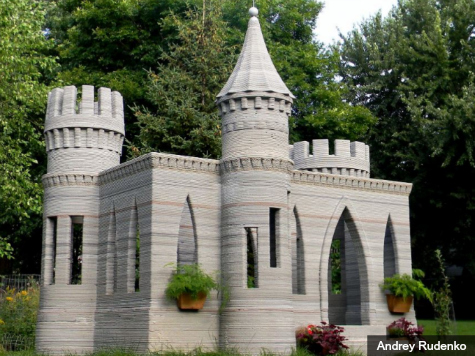A 30-year-old Minnesota man has constructed a concrete children’s playhouse castle in his backyard by using a customized 3D printer. Andrey Rudenko said that there were some difficulties, allowing, “printing the castle turrets by themselves was a bad idea as they were extremely difficult to lift and place.”
Rudenko has a background in engineering and architecture and told 3DPrint.com last April that he would attempt the castle first, then build an energy-saving house with largely thermal mass energy storage principles. He said last April:
A cheap house built in 24 hours is not my goal. My current focus is building well-insulated small or medium-sized homes of a contemporary design, definitely onsite. As an experienced builder, I know that to avoid problems in the future, it is more important to produce homes of a good quality, which may take longer to build than cheaper homes made quickly. It would be more beneficial to print a complete home, including the foundation for the staircase, fireplace, certain furniture (kitchen island etc), columns, interior walls, and any wiring or plumbing that would fit inside the printed walls.
There have been 3D-printed homes in China built in 24 hours, but they were simply the outer shell of the homes. Rudenko believes his own plans would protect workers from coming in contact with an “extensively dust-filled environment.” He said, “This is why I’m currently conducting a large scale of experiments to extend the possibilities of this new technology – printing different elements, structures, and studying and developing new techniques.”
Rudenko’s printer is based on the RepRap project, similar to a huge Mendel with the same Arduino Mega 2560 board and bigger motors. The printer prints 20mm-wide layers that are 5mm in height, and the building material is a cement/sand mix.
Rudenko explained:
I don’t know of any cement mixes with an extremely short setting time. But for the cement mix, if it is not touched or vibrated, each layer does have enough time to become hard enough to layer on top of; especially when it is warm out and sun radiation and wind speeds up the drying/curing time. My biggest problem at the moment is pushing the cement through the pump with its high viscosity. All existing pumps can use medium-viscosity at a high speed, but for the cement printer, a high viscosity at low speed is needed, and this is a new field of research. I have attained good results; however, I will keep advancing my extruder/pump design.
Rudenko told 3DPrint that 3D-printed houses are the wave of the future and would cut the labor involved in building a home. He asserted:
3D printing in construction will not wholly replace previous techniques, and materials such as brick will continue to be utilized. Rather, 3D printing will significantly supplement the manual work. The technology aims to considerably lower production cost, provide a safer and more comfortable building process, and allow for much more architectural flexibility. In place of an entire group of construction workers, two people will facilitate the 3D printing process: one with appropriate computer skills in charge of the programming, and one working with the materials (e.g. sand and cement), placing reinforcing steel bars inside the forms, maintaining the machine at the end of the day, and so forth.

COMMENTS
Please let us know if you're having issues with commenting.